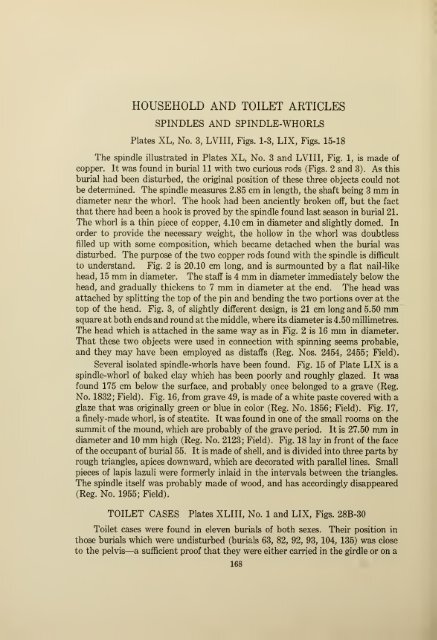A Sumerian Palace and the "A" cemetery at Kish, Mesopotamia
A Sumerian Palace and the "A" cemetery at Kish, Mesopotamia
A Sumerian Palace and the "A" cemetery at Kish, Mesopotamia
You also want an ePaper? Increase the reach of your titles
YUMPU automatically turns print PDFs into web optimized ePapers that Google loves.
HOUSEHOLD AND TOILET ARTICLES<br />
SPINDLES AND SPINDLE-WHORLS<br />
Pl<strong>at</strong>es XL, No. 3, LVIII, Figs. 1-3, LIX, Figs. 15-18<br />
The spindle illustr<strong>at</strong>ed in Pl<strong>at</strong>es XL, No. 3 <strong>and</strong> LVIII, Fig. 1, is made of<br />
copper. It was found in burial 11 with two curious rods (Figs. 2 <strong>and</strong> 3). As this<br />
burial had been disturbed, <strong>the</strong> original position of <strong>the</strong>se three objects could not<br />
be determined. The spindle measures 2.85 cm in length, <strong>the</strong> shaft being 3 mm in<br />
diameter near <strong>the</strong> whorl. The hook had been anciently broken off, but <strong>the</strong> fact<br />
th<strong>at</strong> <strong>the</strong>re had been a hook is proved by <strong>the</strong> spindle found last season in burial 21.<br />
The whorl is a thin piece of copper, 4.10 cm in diameter <strong>and</strong> slightly domed. In<br />
order to provide <strong>the</strong> necessary weight, <strong>the</strong> hollow in <strong>the</strong> whorl was doubtless<br />
filled up with some composition, which became detached when <strong>the</strong> burial was<br />
disturbed. The purpose of <strong>the</strong> two copper rods found with <strong>the</strong> spindle is difficult<br />
to underst<strong>and</strong>. Fig. 2 is 20.10 cm long, <strong>and</strong> is surmounted by a fl<strong>at</strong> nail-like<br />
head, 15 mm in diameter. The staff is 4 mm in diameter immedi<strong>at</strong>ely below <strong>the</strong><br />
head, <strong>and</strong> gradually thickens to 7 mm in diameter <strong>at</strong> <strong>the</strong> end. The head was<br />
<strong>at</strong>tached by splitting <strong>the</strong> top of <strong>the</strong> pin <strong>and</strong> bending <strong>the</strong> two portions over <strong>at</strong> <strong>the</strong><br />
top of <strong>the</strong> head. Fig. 3, of slightly different design, is 21 cm long <strong>and</strong> 5.50 mm<br />
square <strong>at</strong> both ends <strong>and</strong> round <strong>at</strong> <strong>the</strong> middle, where its diameter is 4.50 millimetres.<br />
The head which is <strong>at</strong>tached in <strong>the</strong> same way as in Fig. 2 is 16 mm in diameter.<br />
Th<strong>at</strong> <strong>the</strong>se two objects were used in connection with spinning seems probable,<br />
<strong>and</strong> <strong>the</strong>y may have been employed as distaffs (Reg. Nos. 2454, 2455; Field).<br />
Several isol<strong>at</strong>ed spindle-whorls have been found. Fig. 15 of Pl<strong>at</strong>e LIX is a<br />
spindle-whorl of baked clay which has been poorly <strong>and</strong> roughly glazed. It was<br />
found 175 cm below <strong>the</strong> surface, <strong>and</strong> probably once belonged to a grave (Reg.<br />
No. 1832; Field). Fig. 16, from grave 49, is made of a white paste covered with a<br />
glaze th<strong>at</strong> was originally green or blue in color (Reg. No. 1856; Field). Fig. 17,<br />
a finely-made whorl, is of ste<strong>at</strong>ite. It was found in one of <strong>the</strong> small rooms on <strong>the</strong><br />
summit of <strong>the</strong> mound, which are probably of <strong>the</strong> grave period. It is 27.50 mm in<br />
diameter <strong>and</strong> 10 mm high (Reg. No. 2123; Field). Fig. 18 lay in front of <strong>the</strong> face<br />
of <strong>the</strong> occupant of burial 55. It is made of shell, <strong>and</strong> is divided into three parts by<br />
rough triangles, apices downward, which are decor<strong>at</strong>ed with parallel lines. Small<br />
pieces of lapis lazuli were formerly inlaid in <strong>the</strong> intervals between <strong>the</strong> triangles.<br />
The spindle itself was probably made of wood, <strong>and</strong> has accordingly disappeared<br />
(Reg. No. 1955; Field).<br />
TOILET CASES Pl<strong>at</strong>es XLIII, No. 1 <strong>and</strong> LIX, Figs. 28B-30<br />
Toilet cases were found in eleven burials of both sexes. Their position in<br />
those burials which were undisturbed (burials 63, 82, 92, 93, 104, 135) was close<br />
to <strong>the</strong> pelvis—a sufficient proof th<strong>at</strong> <strong>the</strong>y were ei<strong>the</strong>r carried in <strong>the</strong> girdle or on a<br />
168

















